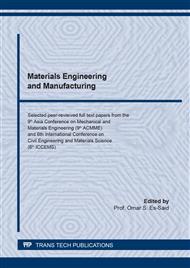[1]
Kim J. Fabrication of conductive polymer/inorganic nanoparticles composite films: PEDOT: PSS with exfoliated tin selenide nanosheets for polymer-based thermoelectric devices[J]. Chemical Engineering Journal, 2016, 297: 66-73.
DOI: 10.1016/j.cej.2016.03.137
Google Scholar
[2]
Handbook of industrial polyethylene and technology: Definitive guide to manufacturing, properties, processing, applications and markets set[M]. John Wiley & Sons, (2017).
DOI: 10.1002/9781119159797.index
Google Scholar
[3]
Bonifazi G, Capobianco G, Serranti S. A hierarchical classification approach for recognition of low-density (LDPE) and high-density polyethylene (HDPE) in mixed plastic waste based on short-wave infrared (SWIR) hyperspectral imaging[J]. Spectrochimica Acta Part A: Molecular and Biomolecular Spectroscopy, 2018, 198: 115-122.
DOI: 10.1016/j.saa.2018.03.006
Google Scholar
[4]
Bhasney S M, Mondal K, Kumar A, et al. Effect of microcrystalline cellulose [MCC] fibres on the morphological and crystalline behaviour of high density polyethylene [HDPE]/polylactic acid [PLA] blends[J]. Composites Science and Technology, 2020, 187: 107941.
DOI: 10.1016/j.compscitech.2019.107941
Google Scholar
[5]
Karaagac E, Koch T, Archodoulaki V.M. The effect of PP contamination in recycled high-density polyethylene (rPE-HD) from post-consumer bottle waste and their compatibilization with olefin block copolymer (OBC)[J]. Waste Management, 2021, 119: 285-294.
DOI: 10.1016/j.wasman.2020.10.011
Google Scholar
[6]
Çavdar A D, Tomak E D, Torun S B, et al. Accelerated Weathering Resistance of High-Density Polyethylene Composites Reinforced with Microcrystalline Cellulose and Fire Retardants[J]. Journal of Building Engineering, 2021: 102282.
DOI: 10.1016/j.jobe.2021.102282
Google Scholar
[7]
Krishnaswamy R.K. Analysis of ductile and brittle failures from creep rupture testing of high-density polyethylene (HDPE) pipes[J]. Polymer, 2005, 46(25): 11664-11672.
DOI: 10.1016/j.polymer.2005.09.084
Google Scholar
[8]
Liu L, Wang F, Xue P, et al. Influence of interfacial condition on rheological instability behavior of UHMWPE/HDPE/nano-SiO 2 blends in capillary extrusion[J]. Rheologica Acta, 2019, 58(3): 183-192.
DOI: 10.1007/s00397-019-01139-x
Google Scholar
[9]
Ruige Q I, Chunxia H E, Jingjing F U, et al. ffect of Inorganic Nanoparticles on the Thermal and Mechanical Properties of Wood Fiber/HDPE Composites[J]. Journal of Shanghai Jiaotong University, 2019, 53(3): 373.
Google Scholar
[10]
Wang W, Mu B, Zhang J, et al. Attapulgite: from clay minerals to functional materials[J]. Scientia Sinica Chimica, 2018, 48(12): 1432-1451.
DOI: 10.1360/n032018-00193
Google Scholar
[11]
Yang H, Tang A, Ouyang J, et al. From natural attapulgite to mesoporous materials: methodology, characterization and structural evolution[J]. The Journal of Physical Chemistry B, 2010, 114(7): 2390-2398.
DOI: 10.1021/jp911516b
Google Scholar
[12]
Duan Z, Zhao Q, Wang S, et al. Novel application of attapulgite on high performance and low-cost humidity sensors[J]. Sensors and Actuators B: Chemical, 2020, 305: 127534.
DOI: 10.1016/j.snb.2019.127534
Google Scholar
[13]
Shi J, Li M. Synthesis and characterization of polyethylene glycol/modified attapulgite form-stable composite phase change material for thermal energy storage[J]. Solar Energy, 2020, 205: 62-73.
DOI: 10.1016/j.solener.2020.05.064
Google Scholar
[14]
Xu Y, Chen D. Self-healing polyurethane/attapulgite nanocomposites based on disulfide bonds and shape memory effect[J]. Materials Chemistry and Physics, 2017, 195: 40-48.
DOI: 10.1016/j.matchemphys.2017.04.007
Google Scholar
[15]
Wen Y, Tsou C H, Gao C, et al. Evaluating distillers grains as bio-fillers for high-density polyethylene[J]. Journal of Polymer Research, 2020, 27: 1-10.
Google Scholar
[16]
Tsou C H, et al. Characterizing Attapulgite-Reinforced Nanocomposites of Poly(lactic acid) [J]. Polymer Science, Series A, 2020, 6 (6): 732–743.
DOI: 10.1134/s0965545x20330068
Google Scholar


